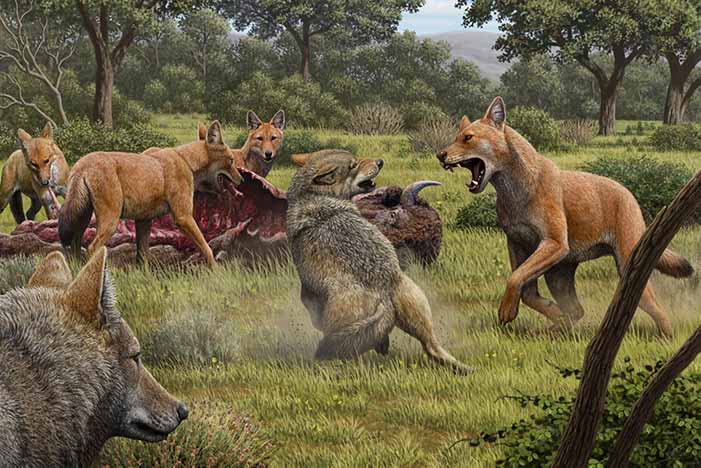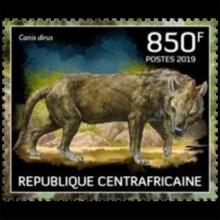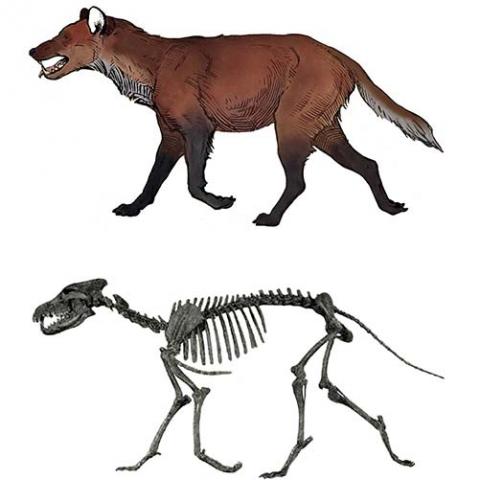NAMES
TAXONOMY
Central African Republic
Issued:
Stamp:
Aenocyon dirus
Central African Republic
Issued:
Stamp:
Aenocyon dirus
Central African Republic
Issued:
Stamp:
Aenocyon dirus
DNA Reveals the Real Lives of ‘Game of Thrones’ Dire Wolves
The species’ remarkable genetic isolation from other wolves may have contributed to its demise.
by James Gorman Published Jan. 13, 2021

The dire wolf, an animal many people know from its fictional incarnation in “Game of Thrones” was a heavy-boned, powerful predator that roamed North America up to about 11,000 years ago, or perhaps even later, preying on large animals like extinct horses, bison, sloths and even mammoths.
While it was nowhere near as big as its television version, the dire wolf was about 20 percent larger on average than the gray wolf, and it was long considered a sister species, Canis dirus rather than Canis lupus.
But an international team of scientists reported Wednesday in the journal Nature that the first sequencing of the dire wolf genome showed an unexpectedly large genetic separation between the two species, big enough that the dire wolf is not just a separate species but a separate genus. They resurrected an old name, Aenocyon, for the genus, first suggested in 1918 by John Merriam, a paleontologist, but soon discarded. The dire wolf is the sole species in the genus.
The last common ancestor of the gray wolf and the dire wolf was about 5.7 million years ago, the researchers reported. And another surprise was that the dire wolf didn’t seem to interbreed with other species — as dogs, wolves, coyotes and other canids do. In evolutionary terms, it met a lonely end.
Angela Perri, an archaeologist at Durham University in England, one of the leaders of the research, said of the new work, “a hundred years later we are saying that Merriam was right.”
What made the change possible was the effort made by the many scientific groups that participated in the project to find enough ancient DNA.
The problem was not a lack of old bones. The vast majority come from the La Brea Tar Pits in Los Angeles County, where the remains of about 4,000 animals have been recovered. Tar apparently plays havoc with recoverable DNA and until now, nobody had been able to sequence the dire wolf’s genome.
The researchers compared the dire wolf data with previously sequenced genomes of a number of other species, including wolves, foxes, jackals and dholes. The data showed how long ago the species split apart and how distant they are.
The long genetic isolation is significant in another way.
Larisa DeSantis, a paleontologist at Vanderbilt University, who was not involved in the research, said it “is consistent with the idea of a North American origin of dire wolves.”
They were here at least 250,000 years ago, and they were still around, although nearing the end of their existence, when the first humans were arriving in the Americas, perhaps 15,000 years ago.
“They were not this ginormous mythical creature, but an animal that most likely interacted with humans,” Dr. Perri said.
In the search for fossils that could provide ancient dire wolf DNA, Dr. Perri joined forces with a number of other researchers around the world, including Kieren Mitchell, an evolutionary biologist at the University of Adelaide; Alice Mouton, a geneticist at the University of Los Angeles; and Sandra Álvarez-Carretero, a genomics doctoral student at Queen Mary University of London.
They combed museums to find 46 bone samples that might have usable DNA. Five did. “We got really lucky,” Dr. Perri said. “And we found a lot of things we didn’t really expect.”
The findings were surprising because dire wolf skeletons are similar to gray wolf skeletons, and because DNA was not available. Xiaoming Wang, a paleontologist at the Los Angeles County Natural History Museum, who published a review of the fossil evidence in 2009 that placed the dire wolf squarely in the genus Canis, called the new paper a “milestone,” adding that “morphology is not foolproof.”<.p>
As to why the dire wolf went extinct and wolves survived, the authors speculated that its long genetic isolation and lack of interbreeding with other species may have made it less able to adapt to the disappearance of its main prey species. More promiscuous species like gray wolves and coyotes were acquiring potentially useful genes from other species.
Laurent Frantz, an ancient DNA specialist at Ludwig Maximilian University in Munich and one of the paper’s authors, said that finding was a reminder of the evolutionary success of gray wolves. Their wide variation in size and ability to adapt to different prey species helped them escape the fate of the dire wolf. Now, of course, they face many threats in Europe and the United States.
“It’s the ultimate carnivore survivor,” he said, “until it faces humans.”
Reference: NYTimes.com
Genus species (Animalia): Aenocyon dirus
The dire wolf (Aenocyon dirus, "terrible wolf") is an extinct canine. It is one of the most famous prehistoric carnivores in North America, along with its extinct competitor the Smilodon. The dire wolf lived in the Americas and eastern Asia during the Late Pleistocene and Early Holocene epochs (125,000–9,500 years ago). The species was named in 1858, four years after the first specimen had been found. Two subspecies are recognized: Aenocyon dirus guildayi and Aenocyon dirus dirus. The dire wolf probably evolved from Armbruster's wolf ("Canis" armbrusteri) in North America. The largest collection of its fossils has been obtained from the Rancho La Brea Tar Pits in Los Angeles.
Dire wolf remains have been found across a broad range of habitats including the plains, grasslands, and some forested mountain areas of North America, the arid savanna of South America, and the steppes of eastern Asia. The sites range in elevation from sea level to 2,255 meters (7,400 ft). Dire wolf fossils have rarely been found north of 42°N latitude; there have been only five unconfirmed reports above this latitude. This range restriction is thought to be due to temperature, prey, or habitat limitations imposed by proximity to the Laurentide and Cordilleran ice sheets that existed at the time. However, the later discovery of Asian dire wolf fossils indicates that dire wolves likely could still persist in these areas, as they would have needed to do so to cross the Bering land bridge.
The dire wolf was about the same size as the largest modern gray wolves (Canis lupus): the Yukon wolf and the northwestern wolf. A. d. guildayi weighed on average 60 kilograms (132 lb) and A. d. dirus was on average 68 kg (150 lb). Its skull and dentition matched those of C. lupus, but its teeth were larger with greater shearing ability, and its bite force at the canine tooth was stronger than any known Canis species. These characteristics are thought to be adaptations for preying on Late Pleistocene megaherbivores, and in North America its prey are known to have included western horses, ground sloths, mastodons, ancient bison, and camels. As with other large Canis hypercarnivores today, the dire wolf is thought to have been a pack hunter. Its extinction occurred during the Quaternary extinction event along with most of the American megafauna of the time, including a number of other carnivores, that occurred soon after the appearance of humans in the New World. Its reliance on megaherbivores has been proposed as the cause of its extinction, along with climatic change and competition with other species, or a combination of those factors. Despite its physical similarities to the gray wolf, it is now known through genetic studies to have been the last member of an ancient lineage of New World canids. Dire wolves lived as recently as 9,500 years ago, according to dated remains.
DNA analysis
In 1992 an attempt was made to extract a mitochondrial DNA sequence from the skeletal remains of A. d. guildayi to compare its relationship to other Canis species. The attempt was unsuccessful because these remains had been removed from the La Brea pits and tar could not be removed from the bone material. In 2014 an attempt to extract DNA from a Columbian mammoth from the tar pits also failed, with the study concluding that organic compounds from the asphalt permeate the bones of all ancient samples from the La Brea pits, hindering the extraction of DNA samples.
A 2021 study sequenced nuclear DNA (from the cell nucleus) of five dire wolf specimens dating from 13,000 to more than 50,000 years ago. The sequences indicate that the ancestors of dire wolves split from the wolf-like canines 5.7 million years ago. The morphological similarity between dire wolves and gray wolves was concluded to be due to convergent evolution. The study supported reclassifying the dire wolf to genus Aenocyon.
Reference: Wikipedia
Synonym: Canis dirus



